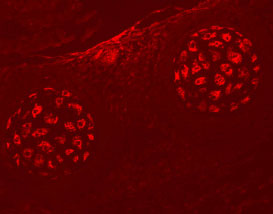Mouse EphA4 Antibody Summary
Val20-Thr547
Accession # Q03137
Applications
Please Note: Optimal dilutions should be determined by each laboratory for each application. General Protocols are available in the Technical Information section on our website.
Scientific Data
 View Larger
View Larger
EphA4 in Embryonic Rat Rib Cartilage Primordium. EphA4 was detected in immersion fixed frozen sections of embryonic rat rib cartilage primordium (E15) using 5 µg/mL Goat Anti-Mouse EphA4 Antigen Affinity-purified Polyclonal Antibody (Catalog # AF641) overnight at 4 °C. Tissue was stained (red). View our protocol for Fluorescent IHC Staining of Frozen Tissue Sections.
Reconstitution Calculator
Preparation and Storage
- 12 months from date of receipt, -20 to -70 °C as supplied.
- 1 month, 2 to 8 °C under sterile conditions after reconstitution.
- 6 months, -20 to -70 °C under sterile conditions after reconstitution.
Background: EphA4
EphA4, also known as Sek, Sek1, Cek8, Hek8, and Tyro1 (1), is a member of the Eph receptor family which binds members of the ephrin ligand family. There are two classes of receptors, designated A and B. Both the A and B class receptors have an extracellular region consisting of a globular domain, a cysteine-rich domain, and two fibronectin type III domains. This is followed by the transmembrane region and cytoplasmic region. The cytoplasmic region contains a juxtamembrane motif with two tyrosine residues, which are the major autophosphorylation sites, a kinase domain, and a conserved sterile alpha motif (SAM) in the carboxy tail which contains one conserved tyrosine residue. Activation of kinase activity occurs after ligand recognition and binding. EphA4 has been shown to bind ephrin-A5, ephrin-A1, ephrin‑A3, ephrin-A2, ephrin-B2, ephrin-B3, and ephrin-A4 (2, 3). The extracellular domains of mouse and human EphA4 share greater than 95% amino acid identity. Only membrane-bound or Fc-clustered ligands are capable of activating the receptor in vitro. While soluble monomeric ligands bind the receptor, they do not induce receptor autophosphorylation and activation (2). In vivo, the ligands and receptors display reciprocal expression (3). It has been found that nearly all receptors and ligands are expressed in developing and adult neural tissue (3). The Eph/ephrin families also appear to play a role in angiogenesis (3).
- Eph Nomenclature Committee [letter] (1997) Cell 9:403.
- Flanagan, J.G. and P. Vanderhaegen (1998) Annu. Rev. Neurosci. 21:309.
- Pasquale, E.B. (1997) Curr. Opin. Cell. Biol. 9:608.
Product Datasheets
Citations for Mouse EphA4 Antibody
R&D Systems personnel manually curate a database that contains references using R&D Systems products. The data collected includes not only links to publications in PubMed, but also provides information about sample types, species, and experimental conditions.
9
Citations: Showing 1 - 9
Filter your results:
Filter by:
-
Neuronal miR-17-5p contributes to interhemispheric cortical connectivity defects induced by prenatal alcohol exposure
Authors: Altounian, M;Bellon, A;Mann, F;
Cell reports
Species: Mouse
Sample Types: Whole Tissue
Applications: Immunohistochemistry -
Tracheal separation is driven by NKX2-1-mediated repression of Efnb2 and regulation of endodermal cell sorting
Authors: AE Lewis, A Kuwahara, J Franzosi, JO Bush
Cell Reports, 2022-03-15;38(11):110510.
Species: Mouse
Sample Types: Whole Tissue
Applications: IF -
The developmental and genetic basis of 'clubfoot' in the peroneal muscular atrophy mutant mouse
Authors: JM Collinson, NO Lindström, C Neves, K Wallace, C Meharg, RH Charles, ZK Ross, AM Fraser, I Mbogo, K Oras, M Nakamoto, S Barker, S Duce, Z Miedzybrod, N Vargesson
Development, 2018-02-08;145(3):.
Species: Mouse
Sample Types: Whole Tissue
Applications: IHC -
EphA4 regulates neuroblast and astrocyte organization in a neurogenic niche
Authors: KL Todd, KL Baker, MB Eastman, FW Kolling, AG Trausch, CE Nelson, JC Conover
J. Neurosci, 2017-03-03;0(0):.
Species: Mouse
Sample Types: Whole Tissue
Applications: IHC -
alpha2-chimaerin is required for Eph receptor-class-specific spinal motor axon guidance and coordinate activation of antagonistic muscles.
Authors: Kao T, Nicholl G, Johansen J, Kania A, Beg A
J Neurosci, 2015-02-11;35(6):2344-57.
Species: Mouse
Sample Types: Cell Lysates
Applications: Western Blot -
Ephrin-B2 governs morphogenesis of endolymphatic sac and duct epithelia in the mouse inner ear.
Authors: Raft S, Andrade L, Shao D, Akiyama H, Henkemeyer M, Wu D
Dev Biol, 2014-02-26;390(1):51-67.
Species: Mouse
Sample Types: Whole Tissue
Applications: IHC -
A novel feedback mechanism by Ephrin-B1/B2 in T-cell activation involves a concentration-dependent switch from costimulation to inhibition.
Authors: Kawano H, Katayama Y, Minagawa K, Shimoyama M, Henkemeyer M, Matsui T
Eur. J. Immunol., 2012-05-23;42(6):1562-72.
Species: Mouse
Sample Types: Cell Lysates
Applications: Immunoprecipitation -
Neural RNA-binding protein Musashi1 controls midline crossing of precerebellar neurons through posttranscriptional regulation of Robo3/Rig-1 expression.
Authors: Kuwako K, Kakumoto K, Imai T
Neuron, 2010-08-12;67(3):407-21.
Species: Mouse
Sample Types: Whole Tissue
Applications: IHC-Fr -
Control of hippocampal dendritic spine morphology through ephrin-A3/EphA4 signaling.
Authors: Murai KK, Nguyen LN, Irie F, Yamaguchi Y, Pasquale EB
Nat. Neurosci., 2003-02-01;6(2):153-60.
Species: Mouse
Sample Types: Whole Tissue
Applications: IHC-Fr
FAQs
No product specific FAQs exist for this product, however you may
View all Antibody FAQsReviews for Mouse EphA4 Antibody
There are currently no reviews for this product. Be the first to review Mouse EphA4 Antibody and earn rewards!
Have you used Mouse EphA4 Antibody?
Submit a review and receive an Amazon gift card.
$25/€18/£15/$25CAN/¥75 Yuan/¥2500 Yen for a review with an image
$10/€7/£6/$10 CAD/¥70 Yuan/¥1110 Yen for a review without an image

